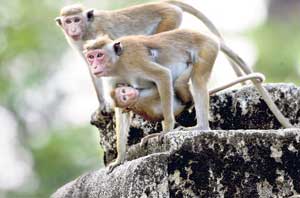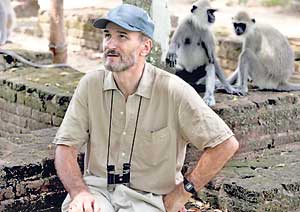Jr, Sirima and Hema are just a few of the 4,000, with no two having the same name.
They are named after politicians, famous people, family and friends. Two brothers are called Ponnam and Peruma, after Cyril Ponnamperuma, the founding head of the Institute of Fundamental Studies (IFS).
Who are they? They are the toque macaques (Macaca sinica) who roam the ancient citadel of Polonnaruwa, the second capital of Ceylon, with whom any visitor to the area is familiar. For they are part of the landscape, gambolling across the pleasure gardens of the kings, with the babies clinging on to their mothers’ under-bellies or peering inquisitively at the human intruders, while perched on a pillar centuries old.
 |
| The toque macaques |
Conceding that it is inevitable to have favourites, top primatologist Dr. Wolfgang Dittus, better known as ‘Wanduru Mahattaya’ (Monkey Gentleman) mentions ‘Not so’, a male which was “not so strong or not so weak”, ‘Hema’, a red-faced female, ‘Stumpy’, a male with a short tail and ‘Saf’, a young female whose entire life he and his team have followed from youth to breeding age and on to old age. “One was even called Lal, after a former girlfriend,” he adds smilingly and when asked whether Jr was a wily one, quickly replies that he was an “innocent fellow who died young”.
And what’s special about these simian cousins of ours in Polonnaruwa is that they are part of the longest-running study of primates in the world being carried out by the Smithsonian Institution in Washington DC, America.
The study is being conducted by Dr. Dittus, Research Biologist for the Smithsonian Institution and Senior Visiting Scientist of the Institute of Fundamental Studies, Kandy, along with a local team headed by Sunil Gunathilake who has been with the programme for 20 years.
These are also the very same monkeys who have shot to fame through many international film documentaries on Discovery Channel, BBC Natural History World and Animal Planet. The latest is ‘Dark Days in Monkey City’ (2009) produced for Animal Planet while some of the others are ‘Temple Troop’, winner of 12 international awards (1997) and ‘Life of Mammals: Social Climbers’ with David Attenborough (2002) both for BBC Natural World.
‘Dark Days in Monkey City’ is about many troops of macaques who fight for dominance in Polonnaruwa. Using the semi-animated graphic-novel visual, it is like ‘300’ and ‘Sin City’, says Dr. Dittus.
Having spent his childhood in Germany where he was born and getting his first degree from McGill University in Canada, Dr. Dittus, who was looking to do a study on primates, was the last person to join the Primate Biology Programme (PBP) of the Smithsonian.
Nobody wanted to do the macaques, he says, when asked why he decided to spend the better part of his life here in Sri Lanka studying these monkeys, “because ‘my fellows’ are considered ugly compared to other good-looking types such as the grey langur”. The macaque is endemic to Sri Lanka and is known locally as rilawa.
 |
| Dr. Dittus. Pix by David Barron |
By the time he joined the PBP, Dr. Dittus was already heavily involved in studying animal communications such as the development of song in birds. “But communication among primates is more complex and the macaques are socially very active.”
It was way back in 1968 that he set up base in Polonnaruwa to study the troops of macaques which rule the ruins there, observing them, identifying them as individuals and taking meticulous notes on their behaviour.
There are around 1,000 at a given time, he says, explaining that he gained his Ph.D from the University of Maryland in America, on the research he did on the ecology and behaviour of macaques, which found that the monkeys’ reproduction and survival (evolutionary fitness) was influenced by their social behaviour.
The macaques live in social matriarchal groups in a certain area, feeding on natural vegetation such as fruit and flowers. Males leave the “mother family” on reaching puberty to find a mate from another troop, according to Dr. Dittus who has numerous publications on a wide range of subjects to his credit.
“There is a genetic-imprinting that prevents inbreeding among macaques even if there is an opportunity to do so. They avoid mating with close relatives because any ancestral macaque with such a predisposition would have been handicapped with few descendants. Thus incest behaviour has been eliminated by natural or genetic selection,” he says.
Although the original mission of the PBP was basic science, it has now developed along three fronts: science, conservation and education. The research includes behaviour, ecology, demography, population genetics, epidemiology, physiology, and comparative socio-ecology among three sympatric (species sharing the same habitat) primate species, says Dr. Dittus.
Apart from the Smithsonian Institution, IFS and the University of Peradeniya (Veterinary Faculty) and a number of international collaborations have been involved in the research, The Sunday Times understands.
As the research is carried out where threats to nature conservation loom large, the PBP has become involved in conservation by establishing the NGO, Association for the Conservation of Primate Diversity to mobilize local leaders in business, education and science, he says.
“We have promoted and participated in film documentaries on the premise that the public will conserve only that which they love, and love only that which they understand,” Dr. Dittus explains. “This has brought the wonders of primate social life into the living rooms of millions of viewers around the globe. We have also got some of them dubbed in Sinhala and telecast on Rupavahini for the home audience,” he says seeking the support of a corporate to do the same with the series ‘Dark Days in Monkey City’.
Stressing that although primates are the focus, the principles and biological phenomena enlightened by these studies have a relevance among vertebrates, especially mammals, Dr. Dittus’s hope is to write up all the data collected, spanning 40 years of research.
Some firsts of PBP
- 1968-2008: World’s longest continuous study among vertebrates, of animal population dynamics, under a varying environment.
- 1977: Discovery of the role of behaviour as the major factor governing mortality and hence the growth (and density) of primate populations and their age-sex compositions.
- 1988: Showed that macaques use referential vocal signals to communicate about the quality, quantity, and distribution of food resources in the environment.
- 1993-2007: Discovered that dengue fever is an epizootic disease in non-human primates of the Sri Lankan dry zone and that human encroachment of wild areas results in the introduction of human diseases to wild primate populations (e.g., toxoplasmosis, cryptosporidosis).
Monkey camp
Small groups of schoolchildren studying science can now go to “monkey camp” at Polonnaruwa, for a reasonable fee, not only to learn about primates but also about plants, with a few lessons on history thrown in courtesy of the Association for the Conservation of Primate Diversity.
|


